November 1, 2007 |
BITE: My Journal
Room with DéjàVu
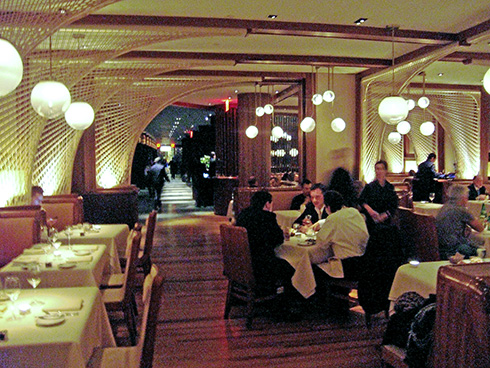 |
Bubbles float in the nautical look of Brasserie 44. Photo: Steven Richter
|
I tried not to see ghosts when I walked into the Royalton Hotel Monday. It doesn’t seem fair to mope just because a new generation has swept up your old stamping ground. Especially since the cool Royalton of designer Philippe Starck, with its mythic restaurant “44” and its flashy chartreuse velvet banquettes was never actually a hangout of mine. I was just a voyeur, in love with Starck’s electric magenta and key lime velvet silver greyhound-legged furniture the minute I walked in and stepped onto the vibrant royal blue runner that led to heady people-watching. Hotelier Ian Shrager, clever pied piper, was honing his technique -- selling pocketsize bedrooms with hot dining and this irresistible lobby.
Alas, the lobby was quickly shabbied when some bean counter draped muslin shrouds on every majestic wing chair and sofa to protect the perfect expanse of velvet from the loitering masses.
“From day one “44” was filled with trendetti,” I wrote in New York in November 1989. Soon it was a lunch canteen for the Conde Nast crowd and dissolute fashion types in dark shades, having breakfast at 2 p.m. “Fashion pages from Details come to life,” I observed. “One Friday at dinner, most everyone looks like a rock group at the very least.”
Enough wallowing in history. Let’s give restaurateur John McDonald (Lever House, Lure, Chinatown Brasserie, Merc Bar) room to work his own pied piper magnetism. After all, Morgans Hotel Group has put $17.5 million into this reclamation. Flames against glass walls, lashings of dark leather, massive pilings of layered iron decreed by designers Roman and Williams frame salons for a lively crowd nibbling and sipping in the darkened lounge.
McDonald has opened the narcissistic bar that once shut itself off from the passing hoi polloi. We catch a couple linking arms in a toast as we navigate toward Brasserie 44, airier and lighter than the lobby cave, nautical with high gloss teak and leather banquettes like a very expensive boat, arches spanned with woven rope, and see-through glass bubbles of light.
The place is brand new – actually it’s the first night, we are told, after several days of warm-ups with friends. The crowd is scant, low energy, and the staff is still finding its sea legs, but Chef Scott Ekstrom, ex of Oceana, is showing his pedigree in a marvelous starter of jumbo lump crab with dill mayo and celery root rémoulade and in carefully roasted wild striped bass striped with asparagus and golden raisin-moscato vinaigrette.
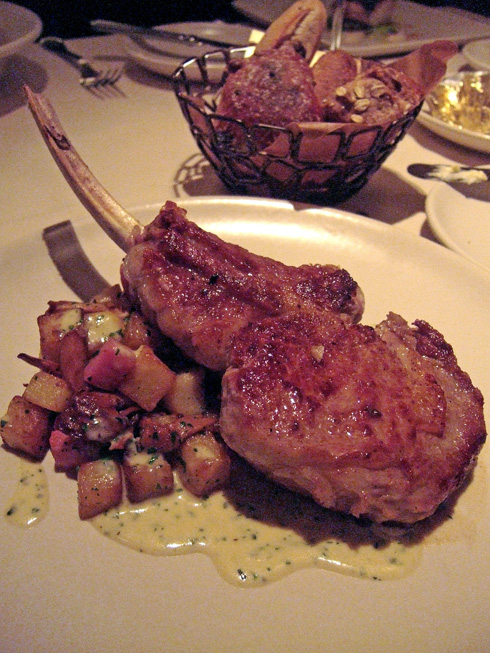 |
The veal chop, a carnivore's dream. Photo: Steven Richter
|
The tables are rather small. That may be why the bread basket is also so small but it’s full of good rolls and comes with a saucer of the legendary French butter, Échirre, in foil (lest you miss the knowing touch) plus a little dish of salt – in case you like your butter salty. Roasted chestnut is the soup of the week it seems. I’ve had three versions in three days but this one, with cippolinis, rutabaga and ginger oil, is the best, and candied walnuts, Boursin and apple cider make a fall green salad special.
Is there a slow-poached egg? Of course there is and the potato pancake it sits on needs to be really crisp. Dry aged rib eye with mini Brussels sprouts and crushed potatoes, and a juicy pan-roasted veal chop, splendidly garnished are first-rate, better choices than lamb shank drowned in a bathtub of gravy.
I like my quince tarte tatin with crème fraîche ice cream but, as our captain explains, the 20% discount through Sunday November 4th is so that we’ll forgive any bumpiness: desserts that need work, the bread that got waylaid, misspellings on the menu.
Will the darlings of yesterday return? Will Tina and Anna Wintour come home again? Lower ranked Condé Nastians have been by to sniff things out. We shall see.
44 West 44th Street. 212 944 8844.
***
Pop Up Eats
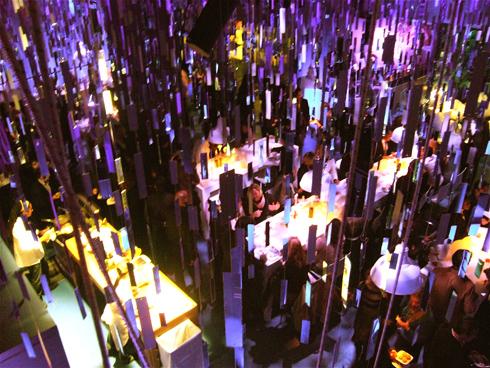 |
Bon Appetit's Disco is a risotto inferno in David Rockwell's Mylar madness.
Photo: Steven Richter
|
In the olden days, when not everyone and their cousins from Toledo were sprouting restaurant critiques at the drop of a crab cake, life moved in the slow lane and I had time for two desserts. But now there is marketing…hundreds of people who might otherwise not be working, I suppose, unleash a brainstorm every few minutes. I am dazzled by their cleverness. The Pop Up restaurant that captures our increasingly splintered attention is the new rage.
Bon Appétit’s throbbing disco madness of a lounge for private parties at night and people’s canteen feeding passerby lunch by day will vanish at week’s end after a hullabaloo’d run. It’s been an especially hot item on the television screen in all my taxis. David Rockwell’s elves got to reproduce a sparkling Studio 54 look overnight. What that boy can do with Mylar. Steven Richter, whose photos you see everywhere on this site, captured that magic the evening Bon Appétit celebrated it’s coup. It was a boogy night without boogy or cocaine. Govind Armstrong’s truffled risotto is our drug these days.
***
Buy a Van Gogh for Auvers-sur-Oise
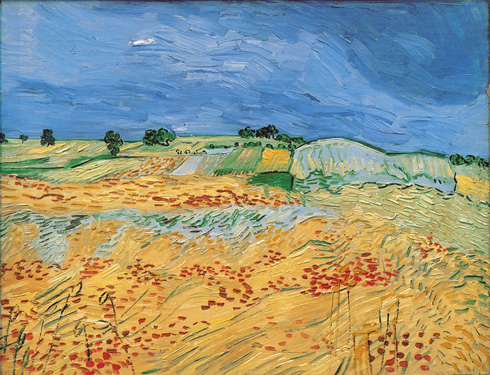 |
On Sale at Sotheby's: "The Fields".
|
Ten years ago the Road Food Warrior and I made a pilgrimage from Paris to Auvers-sur-Oise, the town where Vincent Van Gogh killed himself after a ten-week fury of astonishing work. We would visit Auberge Ravoux, the inn where he slept and ate his meals…Oh yes, always the restaurant critic. My Parisian guru, Yanou Collart -- in my memoir, Insatiable, I call her “The Woman Who Gave Me France on a Plate” – sent us on this detour. But she didn’t have to convince me. I was a Van Gogh buff. I was in love with his work…had wept for him, for the world’s neglect and disdain. As a teenager I even thought I was Van Gogh. (Then I stopped trying to paint and started writing.)
The remembered sense of moving through the village of Auvers in a time warp, of seeing his ghost everywhere, came back to me when I read the Oct. 21st piece in The New York Times about the determination of the inn’s Belgian owner, Dominque-Charles Janssens, to have a Van Gogh painting on the wall of the tiny room where the artist died. There’s one for sale in New York at Sotheby’s November 7, “Wheat Fields” -- value estimated at $28 - $35 million, and he wants it. All he needs is money. So he’s set up a foundation and a website – donors will get a personal access code so they can view the painting on the wall through a web camera at any time.
“I want to bring back the painting to hang where it once dried so that Van Gogh can achieve the dream he wrote about in a letter to his brother Theo, ‘I hope I can have my own exhibition one day in a café,'” Janssens said..
My friend Yanou is on the case, wiring the world from Paris. I just got a copy of her eblast to her myriad of wealthy friends urging them to buy the painting and donate it to the Auberge. I got a frisson of excitement when I read it. Two determined Belgians fueled by a momentous dream…on the internet no less. www.vangoghsdream.org
And if through some wild twist of fate, a major mogul buys the painting and selflessly sends it to M. Janssens, would the spirit of Van Gogh stir and smile in his grave? Would Theo laugh through his tears?
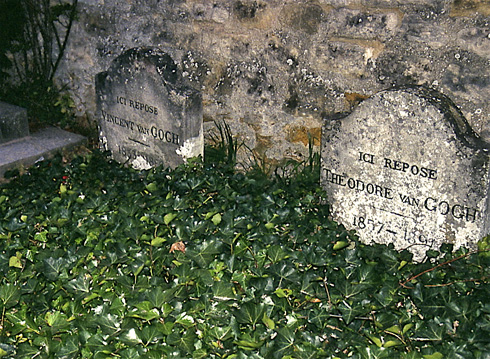
|
|
Vincent and Theo side by side in the cemetary of Auvers, Photo: Steven Richter
|
A visit to Auberge Ravou can spook you. The story I wrote appeared in the September, 1996 issue of Penthouse.
A Pilgrimage to Auvers-sur-Oise
Twenty two miles from Paris --- by bus or train or car --- Auvers-sur-Oise lives in the past. The same quaint village that drew such artists as Pissaro, Daumier and Cezanne now draws the curious, like us, intent on walking in the footsteps of Vincent Van Gogh. The troubled artist came from Paris by train in May of 1890, found Auvers "profoundly beautiful," as he wrote his brother Theo, and in just ten weeks completed an explosion of work --- 70 paintings, oil studies, drawings. We arrive in time to visit the small cemetery where Vincent and Theo lie side by side under a coverlet of tangled ivy. With a "passport" and map purchased from the House of Van Gogh we can see what Vincent and Cezanne saw. Reproductions of each canvas stand on the spot where they set their easels. A drink seems called for, so we retreat to the Maison Ravoux to our reserved table in the rustic country inn where Van Gogh boarded.
We are the sole pilgrims dining with a handful of locals. The waitress sets a country terrine on the table in its baking dish and a crock of pickles so we can help ourselves. The menu is modest: leg of lamb cooked till it falls apart. A crisp brown hash of pig's feet and oxtail. Chicken braised in cream. The same homey country cooking the artist might have eaten a century earlier. And delicious. As Auberge guests we are invited up the narrow creaking stairs. Only five at a time can enter his room, austerely furnished as it was then, when he slept with many of his most famous paintings stacked under his bed. Next door we sit for a short sound and slide show -- grainy photographs of 1890 Auvers fade into the color and intensity of his paintings. It is easy to imagine that it’s his voice reading from haunting letters to brother Theo, "The prospect grows darker, I see no happy future at all." The tiny room, almost empty, vibrates with energy. Of course we know how it ends. The shot, the lingering last night, brother Theo arrives to watch him die, at 37. The intimacy of the experience is fiercely moving. (call 33-1-34 48 05 47)